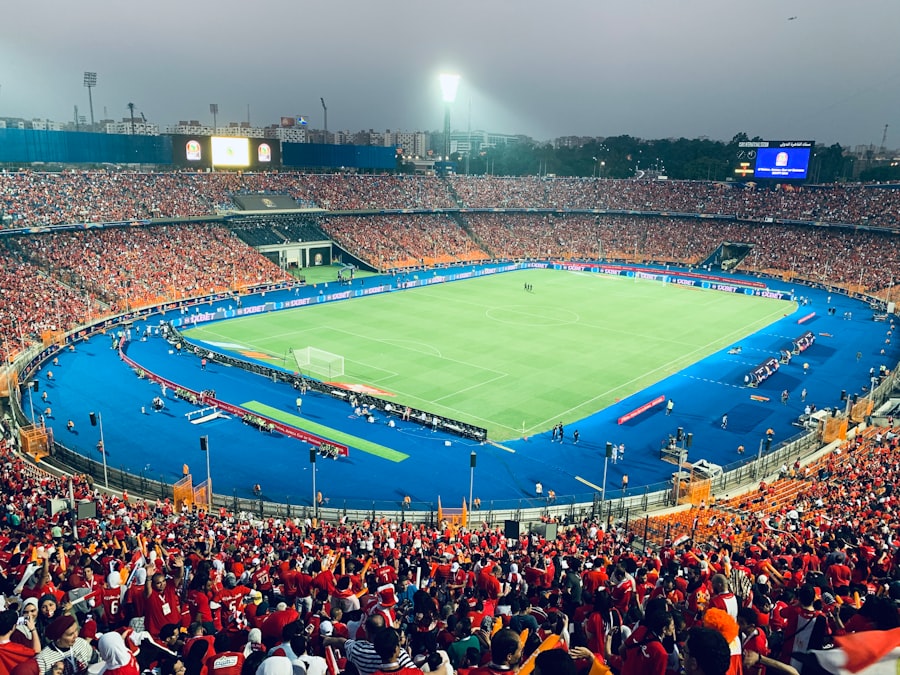The FIFA World Cup 2022, held in Qatar, marked a significant milestone in the history of international football, not only for its competitive spirit but also for its unprecedented global reach. The tournament attracted attention from millions of fans across the globe, transcending geographical boundaries and cultural differences. With an estimated audience of over 3.5 billion viewers, the World Cup served as a powerful platform for showcasing the sport’s universal appeal.
This event was not merely a series of matches; it was a celebration of diversity, uniting people from various backgrounds under the shared passion for football. The global reach of the World Cup extended beyond just viewership statistics. It involved a complex web of media coverage, sponsorship deals, and fan engagement strategies that spanned continents.
Major broadcasters from different countries invested heavily in broadcasting rights, ensuring that matches were accessible to audiences worldwide. The event also saw a surge in tourism, with fans traveling to Qatar from all corners of the globe to witness the action live. This influx of visitors not only boosted local economies but also fostered cultural exchanges, as fans shared their traditions and experiences with one another, further enhancing the tournament’s global significance.
Key Takeaways
- The FIFA World Cup 2022 has a vast global audience, offering extensive reach for marketing efforts.
- Engaging football fans’ passion is key to creating impactful and memorable campaigns.
- Innovative marketing strategies combined with social media enhance fan interaction and brand visibility.
- Partnerships with sponsors amplify campaign effectiveness and broaden promotional opportunities.
- Emphasizing sustainability and social responsibility strengthens brand reputation and long-term impact.
Leveraging the excitement and passion of football fans
Football fans are known for their unwavering loyalty and passion for their teams, and this fervor presents a unique opportunity for marketers during the World Cup. The excitement surrounding the tournament creates an environment ripe for engagement, where brands can tap into the emotional connection fans have with the sport. By aligning their messaging with the values and sentiments associated with football, companies can create campaigns that resonate deeply with their target audiences.
For instance, brands often leverage national pride during the World Cup, crafting advertisements that evoke feelings of unity and patriotism among fans. Moreover, the passion of football fans is not limited to just watching matches; it extends to various forms of expression, including social media interactions, merchandise purchases, and participation in fan events. Marketers can harness this enthusiasm by creating interactive experiences that allow fans to engage with their favorite teams and players.
For example, brands might host viewing parties or fan zones where supporters can gather to watch matches together, fostering a sense of community and shared experience. By tapping into this collective excitement, companies can build stronger connections with consumers and enhance brand loyalty.
Creating innovative and engaging marketing campaigns

In an era where consumers are bombarded with advertisements, standing out during the FIFA World Cup requires creativity and innovation. Brands must develop marketing campaigns that not only capture attention but also engage audiences on a deeper level. One effective approach is to incorporate storytelling into marketing efforts, allowing brands to connect emotionally with fans.
For instance, campaigns that highlight personal stories of players overcoming adversity or celebrating their cultural heritage can resonate strongly with audiences, making them more likely to engage with the brand. Additionally, experiential marketing has emerged as a powerful tool for brands looking to make a lasting impression during the World Cup. By creating immersive experiences that allow fans to interact with the brand in meaningful ways, companies can foster a sense of connection that goes beyond traditional advertising.
For example, brands might set up interactive installations at fan zones or stadiums where supporters can participate in challenges or games related to football. These experiences not only entertain but also create memorable associations with the brand, ultimately driving consumer loyalty.
Utilizing social media and digital platforms to connect with fans
| Metric | Description | Example Value | Importance |
|---|---|---|---|
| Follower Growth Rate | Percentage increase in followers over a specific period | 12% monthly | Measures audience expansion |
| Engagement Rate | Ratio of interactions (likes, comments, shares) to total followers | 4.5% | Indicates fan interaction and content relevance |
| Average Reach per Post | Number of unique users who see a post | 15,000 users | Shows content visibility |
| Click-Through Rate (CTR) | Percentage of users clicking on links in posts | 3.2% | Measures effectiveness of call-to-action |
| Response Time to Fan Messages | Average time taken to reply to fan inquiries | 2 hours | Reflects fan engagement and support quality |
| Content Share Rate | Percentage of followers sharing content | 1.8% | Indicates content virality |
| Video Views | Number of times video content is viewed | 50,000 views per video | Measures video content popularity |
| Hashtag Usage | Number of times branded hashtags are used by fans | 5,000 uses/month | Tracks fan participation and brand awareness |
In today’s digital age, social media has become an indispensable tool for brands looking to connect with football fans during major events like the World Cup. Platforms such as Twitter, Instagram, and TikTok provide unique opportunities for real-time engagement, allowing brands to share updates, behind-the-scenes content, and interactive posts that resonate with audiences. By leveraging these platforms effectively, companies can create a sense of immediacy and excitement around their campaigns, encouraging fans to participate in conversations and share their own experiences.
Moreover, user-generated content plays a crucial role in enhancing brand visibility during the World Cup. Encouraging fans to share their own stories, photos, and videos related to the tournament can amplify a brand’s reach exponentially. For instance, brands might launch hashtag campaigns that invite fans to showcase their support for their national teams or share their favorite World Cup moments.
This not only fosters community engagement but also allows brands to tap into authentic content created by passionate supporters, further enhancing their credibility and relatability.
Collaborating with sponsors and partners for maximum impact
Collaboration is key when it comes to maximizing the impact of marketing efforts during the FIFA World Cup. Brands often partner with sponsors and other organizations to create synergistic campaigns that leverage each other’s strengths. For example, a beverage company might collaborate with a sports apparel brand to create co-branded merchandise or promotional events that attract fans’ attention.
By pooling resources and expertise, these partnerships can amplify brand visibility and create more engaging experiences for consumers. Additionally, collaborating with local businesses and organizations in Qatar can enhance a brand’s authenticity and relevance during the tournament. By supporting local initiatives or participating in community events, brands can demonstrate their commitment to the host country while also connecting with fans on a more personal level.
This approach not only strengthens brand reputation but also fosters goodwill among consumers who appreciate companies that invest in local communities.
Showcasing the cultural and economic opportunities of hosting the World Cup

The FIFA World Cup is not just a sporting event; it is also an opportunity for host countries to showcase their culture and economic potential on a global stage. Qatar’s hosting of the 2022 tournament provided a unique platform for promoting its rich heritage and modern advancements. Marketers can leverage this aspect by highlighting cultural events, local traditions, and economic initiatives associated with the World Cup in their campaigns.
For instance, showcasing Qatari cuisine or traditional music during promotional events can create a deeper connection between fans and the host nation. Furthermore, the economic opportunities generated by hosting the World Cup are significant. From infrastructure development to tourism growth, the tournament has far-reaching implications for local economies.
Brands can capitalize on this narrative by emphasizing their role in supporting economic growth through sponsorships or partnerships with local businesses. By aligning their messaging with the broader economic benefits of hosting the World Cup, companies can position themselves as contributors to positive change while also enhancing their brand image.
Incorporating sustainability and social responsibility into marketing efforts
As global awareness of environmental issues continues to rise, incorporating sustainability into marketing strategies has become increasingly important for brands during major events like the FIFA World Cup. Consumers are more likely to support companies that demonstrate a commitment to social responsibility and environmental stewardship. Brands can showcase their sustainability initiatives by highlighting eco-friendly practices related to their products or operations during the tournament.
For example, companies might promote sustainable merchandise made from recycled materials or implement initiatives aimed at reducing waste during fan events. Additionally, partnering with organizations focused on social causes—such as youth development through sports—can enhance a brand’s reputation as a socially responsible entity. By aligning marketing efforts with sustainability goals, brands not only appeal to environmentally conscious consumers but also contribute positively to society.
Measuring the success and impact of FIFA World Cup 2022 marketing strategies
To evaluate the effectiveness of marketing strategies implemented during the FIFA World Cup 2022, brands must establish clear metrics for success. This involves analyzing various data points such as engagement rates on social media platforms, sales figures related to promotional campaigns, and overall brand sentiment among consumers. By employing analytics tools and methodologies, companies can gain insights into how well their campaigns resonated with audiences.
Furthermore, conducting post-event surveys or focus groups can provide valuable qualitative feedback on consumer perceptions of marketing efforts during the tournament. Understanding what worked well and what could be improved allows brands to refine their strategies for future events while ensuring they remain relevant in an ever-evolving market landscape. Ultimately, measuring success is not just about quantifying results; it is about understanding the impact of marketing initiatives on brand loyalty and consumer relationships in the long term.



